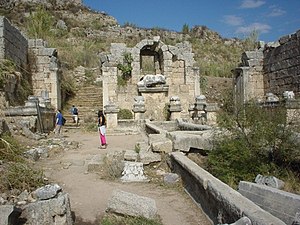Perga or Perge (Greek: Î ÎÏγη Perge, Turkish: Perge) was an ancient Anatolian city in modern Turkey, once the capital of Pamphylia Secunda, now in Antalya province on the southwestern Mediterranean coast of Turkey. Today it is a large site of ancient ruins 15 kilometres (9.3 mi) east of Antalya on the coastal plain. Located there is an acropolis dating back to the Bronze Age.
History

Perga was an ancient and important city of Pamphylia, between the rivers Catarrhactes and Cestrus. It was renowned for the worship of Artemis, whose temple stood on a hill outside the town, and in whose honour annual festivals were celebrated. The coins of Perge represent both the goddess and her temple. Alexander the Great occupied Perge with a part of his army after quitting Phaselis, between which two towns the road is described as long and difficult.
Alexander's rule was followed by the Diadochi empire of the Seleucids.
In 46Â A.D., according to the Acts of the Apostles, St. Paul journeyed to Perga, from there continued on to Antiocheia in Pisidia, then returned to Perga where he preached the word of God (Acts 14:25). Then he left the city and went to Attaleia.
In the first half of the 4th century, during the reign of Constantine the Great (324-337), Perga became an important centre of Christianity, which soon became the official religion of the Roman Empire. The city retained its status as a Christian centre in the 5th and 6th centuries.
Ecclesiastical history
St. Paul the Apostle and his companion St. Barnabas, twice visited Perga as recorded in the biblical book, the Acts of the Apostles, during their first missionary journey, where they "preached the word" before heading for and sailing from Attalia (modern-day Antalya city), 15 kilometres (9.3Â mi) to the southwest, to Antioch.
Paul and Barnabas came to Perge during their first missionary journey, but probably stayed there only a short time, and do not seem to have preached there; it was there that John Mark left Paul to return to Jerusalem. On his return from Pisidia Paul preached at Perge.
St. Matrona of Perge of the 6th century was a female saint known for temporarily cross-dressing to avoid her abusive husband. She also is known for opposing the Monophysite policy of the emperor Anastasios I. Matrona hid in the monastery of St. Bassion as the enuch Babylos. Once revealed, she was sent to a woman’s monastery where she was head of the convent. She was famous for her miraculous gift of healing. She went on to found a nunnery in Constantipole. St Matrona died at the age of 100. Her life was told through a vita prima whose author and exact time period remains a mystery.
The Greek Notitiae episcopatuum mentions the city as metropolis of Pamphylia Secunda until the 13th century. Le Quien gives the names of 11 of its bishops: Epidaurus, present at the Council of Ancyra in 312; Callicles at the First Council of Nicaea in 325; Berenianus, at Constantinople (426); Epiphanius at the Second Council of Ephesus (449), at the First Council of Chalcedon (451), and a signatory of the letter from the bishops of the province to Emperor Leo (458); Hilarianus, at a council at Constantinople in 536; Eulogius, at the Second Council of Constantinople in 553; Apergius, condemned as a Monothelite at the Third Council of Constantinople in 680; John, at the Trullan council in 692; Sisinnius Pastillas about 754 (an iconoclast who was condemned at the Second Council of Nicaea in 787); Constans, at the same council of that condemned his predecessor; John, at the Council of Constantinople of 869â€"70.
No longer a residential, the bishopric is included in the Catholic Church's list of titular sees.
Remains

Perga is today an archaeological site and a tourist attraction. Ancient Perge, one of the chief cities of Pamphylia, was situated between the Rivers Catarrhactes (Düden Nehri) and Cestrus (Aksu), 60 stadia (about 11.1 kilometres (6.9 mi)) from the mouth of the latter; the site is in the modern Turkish village of Murtana on the Suridjik sou, a tributary of the Cestrus, formerly in the Ottoman vilayet of Konya. Its ruins include a theatre, a palæstra, a temple of Artemis and two churches. The temple of Artemis was located outside the town.
Notables

- Perga's most celebrated ancient inhabitant, the mathematician Apollonius (c.262 BC â€" c.190 BC), lived and worked there. He wrote a series of eight books describing a family of curves known as conic sections, comprising the circle, ellipse, parabola, and hyperbola.
Notes

External links

 Chisholm, Hugh, ed. (1911). "Perga". Encyclopædia Britannica (11th ed.). Cambridge University Press.Â
- Â "Perge". Catholic Encyclopedia. New York: Robert Appleton Company. 1913.Â
- Â This article incorporates text from a publication now in the public domain:Â Easton, Matthew George (1897). "article name needed". Easton's Bible Dictionary (New and revised ed.). T. Nelson and Sons.Â
- Perge Guide and Photo Album
- Over 500 pictures including 2013 excavations
- Perge photo
 This article incorporates text from a publication now in the public domain: Herbermann, Charles, ed. (1913). "Perge". Catholic Encyclopedia. Robert Appleton Company.  This article incorporates text from a publication now in the public domain: Smith, William, ed. (1854â€"1857). "Perge". Dictionary of Greek and Roman Geography. London: John Murray.Â

